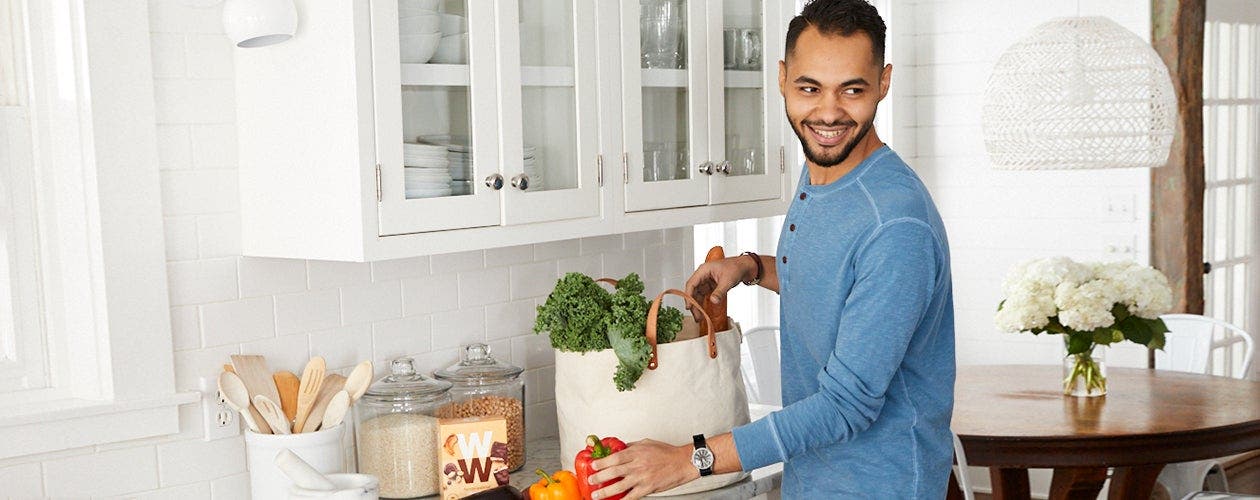Be a smart supermarket shopper


Planning your supermarket shopping
Want to stick to your healthy eating resolve while grocery shopping? The key is to plan ahead.
These days, the weekly food shop can be a complicated chore – hundreds of products to choose from, ambiguous food labels that make products sound healthier than they really are and large store layouts specifically designed to entice buying. It can spell disaster if you’re trying to lose weight. But, arm yourself with our expert tips and tricks and you'll emerge from the supermarket with waistline-friendly groceries and a healthier bank balance, to boot.
Be a savvy shopper
Bring your grocery expedition in line with your weight loss goals with these strategies:
- Stick to the perimeters: “Most packaged and processed foods are stocked in the centre aisles, while fresh food and staples, including bread, fruit, dairy produce and meat, is found on the perimeter aisles,” says accredited practising dietitian Amanda Clark. “To save time, money and kilojoules, skip the confectionary, biscuit, chips and soft-drink aisles that are usually always towards the centre of supermarkets.”
- Make a list before you go: “Think about your menu for the week and you’ll have a clear plan when entering the supermarket, instead of leaving things to chance,” says Clark. Need an incentive to avoid foods not on your list? Melbourne-based accredited practising dietitian Melanie McGrice recommends setting a financial budget. “You’re much less likely to stray from your list and buy foods you don’t need when you’re conscious about sticking to a budget.”
- Don’t shop when you’re hungry: “Self-control is diminished by stressors like hunger,” explains Clark. Time your shopping to take place after a meal. “If you do find yourself out at snack time, a small skim-milk-based coffee makes a satisfying snack,” she adds.
- Remember your nutritional goals: “When you enter the supermarket, remind yourself of what you’re trying to achieve,” advises Clark. “Whether it’s only buying unprocessed foods or that you’re trying to lose weight, it will put you in the right frame of mind and help you fill your trolley with what you intend to.”
Stock up on staples
When it comes to shopping-trolley staples, make the best choices with these tips:
- Milk: “Opt for low-fat or skim milk,” recommends Clark.“ A particularly good choice is milk fortified with vitamin D, especially for people who are overweight, since research has made a connection between being overweight and being more likely to have low vitamin D levels.”
- Cereal: “The main thing you need to look for is fibre,” says accredited practising dietitian Kate Deppeler. “Fibre is filling and relatively low in kilojoules. Choose the right one and a breakfast cereal can be the ideal opportunity to consume 15 per cent of your daily fibre requirements in one meal.”
- Yoghurt: “Choosing a product that’s lower in fat is important,” says McGrice. “The other thing people should look for is how much sugar has been added; not total sugars because yoghurt naturally contains lactose, a milk sugar, but added sugar. If that's listed in the nutritional information as one of the first three ingredients, choose another brand.”
- Bread: “Choosing a dense bread, be it a hearty bread with lots of wholegrains, a sourdough or a fruit loaf packed with fruit, is a good idea,” says McGrice. “And consider your portion sizes. Some loaves have large, thick slices, so be aware how much one slice contributes to your daily energy intake.”
- Meat: Lean and unprocessed are the key things to look for. “Choose lean cuts of beef, lamb, pork and skinless chicken and limit processed meats like salami, prosciutto and sausages because they’re typically high in fat, especially saturated fat,” advises Deppeler. Portion sizes are also important. “Aim to buy cuts of meat in the right portions for convenience and to avoid eating more than you intended,” suggests Clark.
Decoding food labels
Confused by words that make foods sound healthier than they really are? Learn how to interpret five common food labels.
*Cholesterol free- This doesn't necessarily mean a food is healthy. “It’s often slapped on foods that never contained cholesterol in the first place,” explains McGrice. “If people are worried about their cholesterol levels – and they should be – it’s saturated fat you need to avoid, not the cholesterol found naturally in some foods.”
*No added sugar- This doesn't mean a product doesn't contain sugar, just that extra sugar hasn't been added. “Even when only natural sugars are included in the mix, a product can still be high in kilojoules, so always read the nutrition information panel on food labels,” advises McGrice.
*93-per-cent fat-free- "Another way of looking at this,” suggests Deppeler, “is to flip it around and then you’ll realise it still contains seven per cent fat. If you’re trying to lose weight, that can account for nearly 18 per cent of your daily fat intake.”
* Fat-free: “This doesn't mean the food product is kilojoule free and it doesn't necessarily mean it’s a healthy product either,” says McGrice. “Particularly if, like sugary products, it never contained fat in the first place.”
*Light or lite- Don’t be fooled by this ambiguous term, warns Deppeler. “It isn't necessarily talking about the fat or energy content of a food, but often its colour, texture or flavour. You need to read the nutrition information panel to properly assess what the term is actually referring to.”
